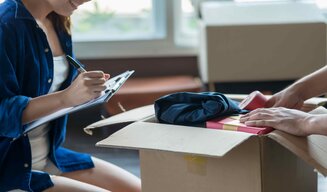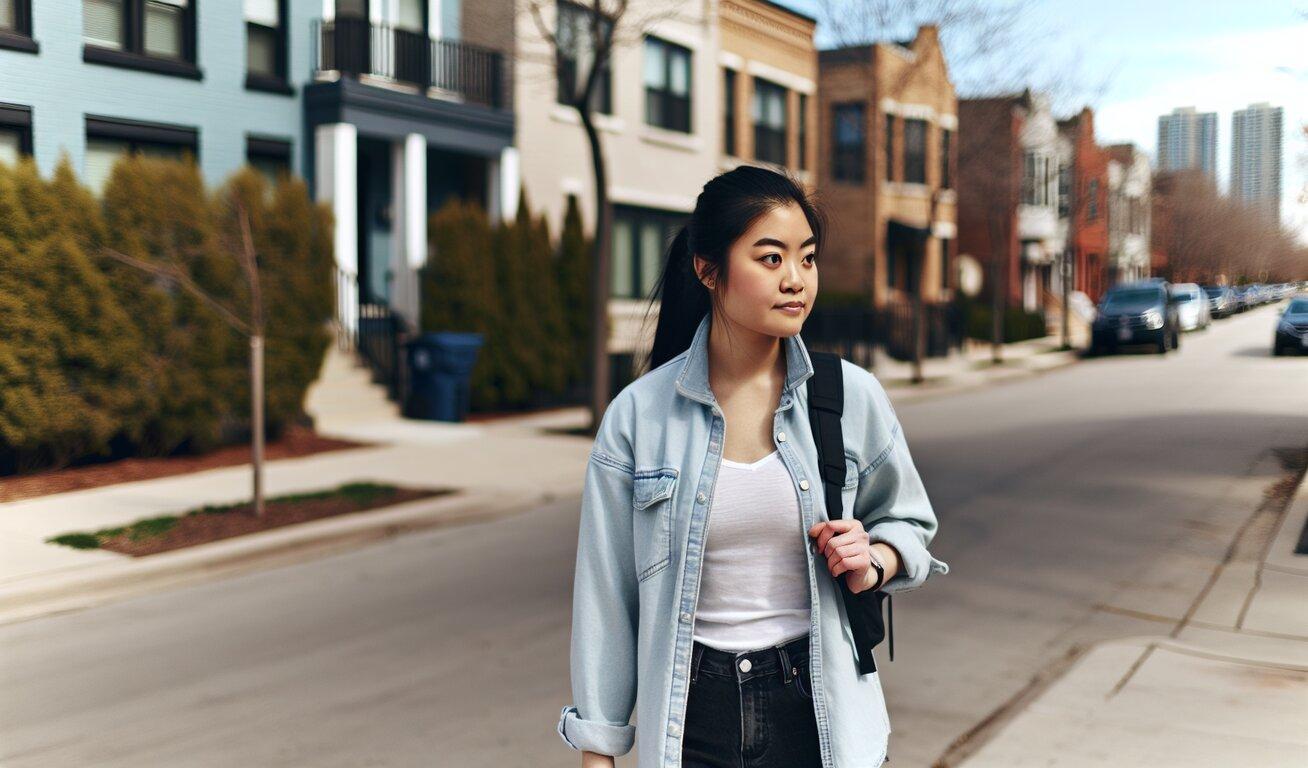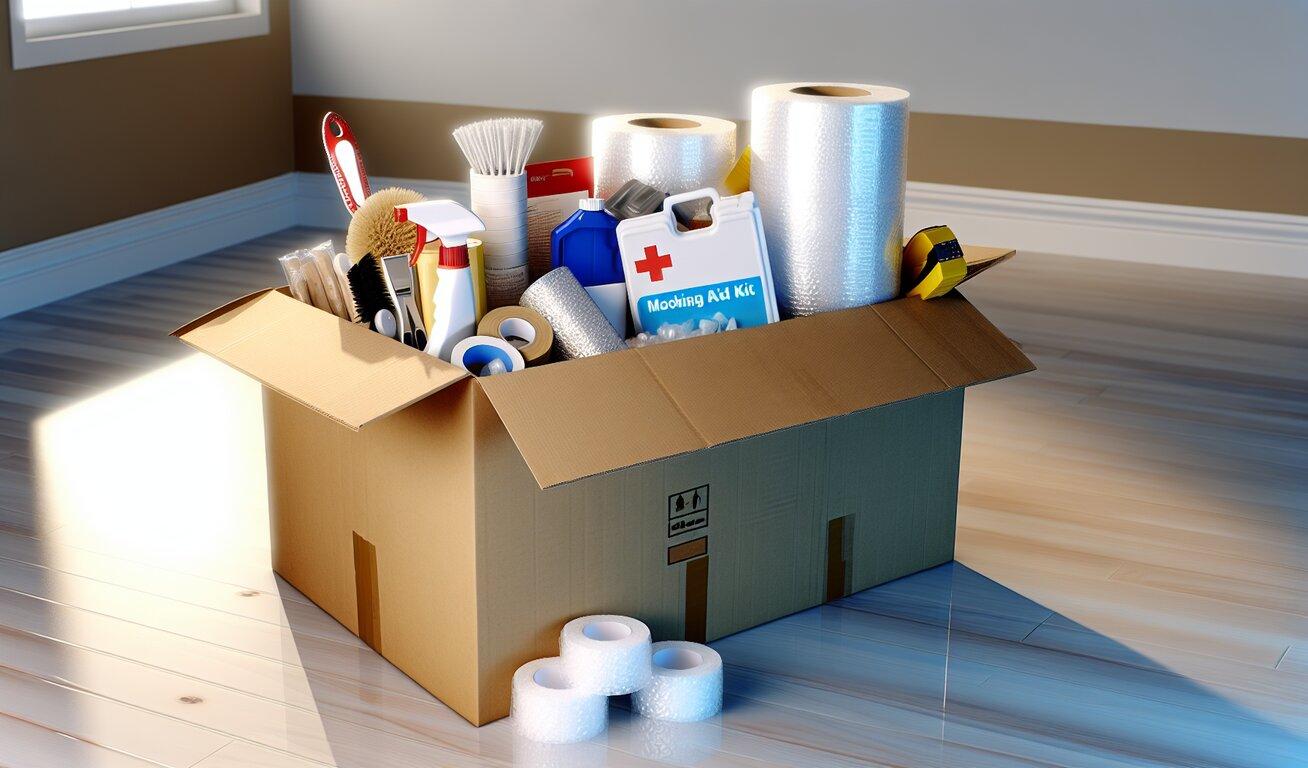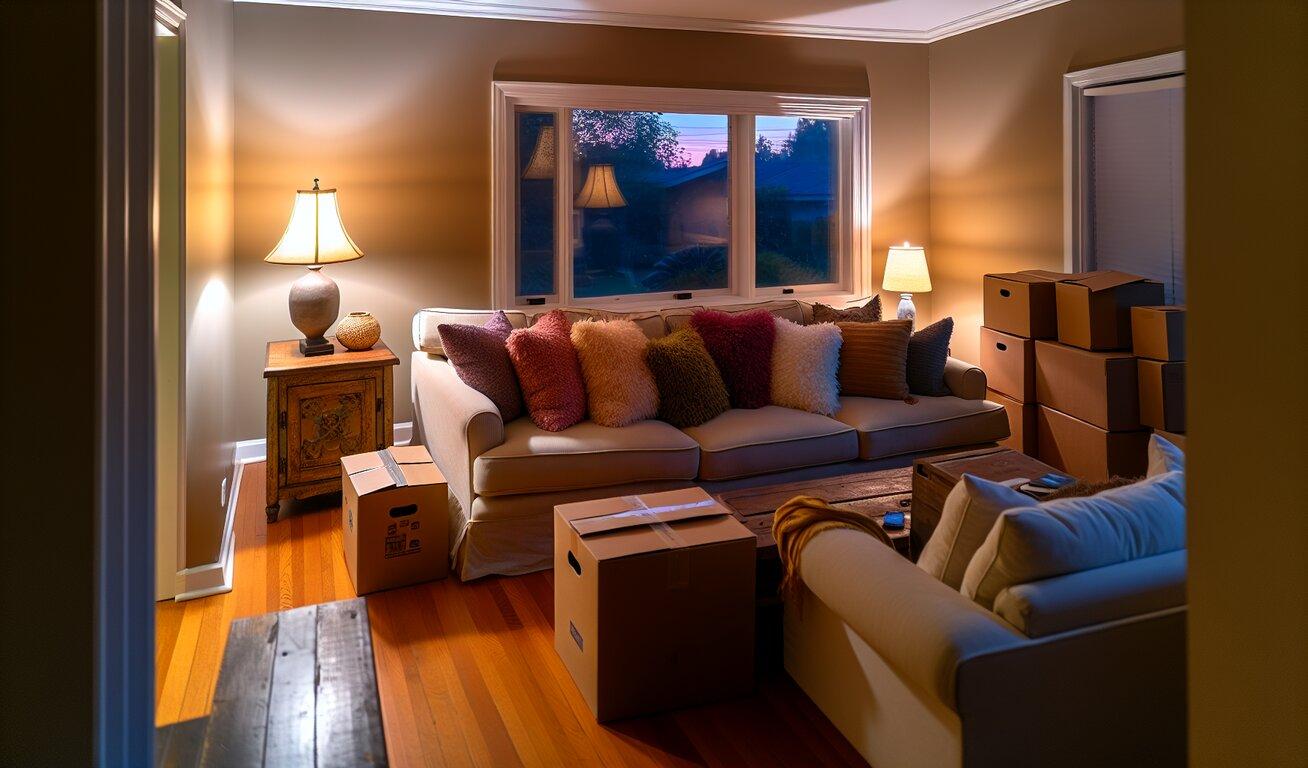Ready to embark on your first move? Minimize stress and ensure you've got everything sorted out with our first-time moving-out checklist. From financial planning and finding a place to the essentials of packing and setting up your new home, we've laid out all the must-dos and must-haves efficiently and clearly.
Essential First-Time Moving Out Checklist:
Your Must-Have Guide

Key Takeaways
- Financial preparedness for moving out includes budgeting for rent and expenses, saving for moving costs like security deposits and movers' fees and planning an emergency fund to cover unexpected expenses or potential renters' insurance.
- Choosing the right apartment involves assessing factors like location, rent, amenities, neighborhood safety, and compatibility with roommates while pre-visiting areas and inspecting potential apartments for health and safety issues.
- Successful moving includes affording necessary furniture, protecting items during transport, updating personal records with new address information, setting up utilities, packing essentials strategically, and finally settling into the new home by making it comfortable and personal.
Financial Preparation for Moving Out

Being financially ready is a substantial stride towards independence as you plan to move out. You're not just investing in a new apartment but a new lifestyle that comes with accessory responsibilities.
In addition to reserving money for the initial rent and security deposit, planning for continuous living expenses and possible emergencies is a must. Honing personal financial management skills paves the way for a smooth transition into independence.
This means understanding your income and expenses, saving for move-in costs, and preparing for unexpected expenses. Remember, financial preparation is a significant step in your first apartment checklist.
Budgeting for Rent and Living Expenses
In planning your budget for your initial apartment, it's vital to ascertain that the rent and living costs are within your means. A popular rule of thumb is the 50/30/20 budget rule, which advises allocating 50% of your income to essentials, 30% to wants, and 20% to savings. This can be an effective starting point in managing your finances and ensuring you can afford your new apartment.
Tools like budgeting apps or spreadsheets can help you track income and expenses thoroughly. Don't overlook small, frequent expenditures like parking fees, meals, and convenience store purchases. These can add up and significantly impact your budget.
Saving for Moving Costs
Securing an apartment is more than just paying the first month's rent. You'll also need a security deposit and, potentially, money for a moving company. These costs can accumulate rapidly, highlighting the need to begin saving as soon as possible.
If you're opting for professional movers, remember to include their fees in your moving budget. Having a financial buffer in place will not only ensure a smooth transition to your new living space but also keep stress levels low when the move-in day arrives.
Planning for Unexpected Expenses
Moving out for the first time frequently brings about unforeseen expenses. You might find that your new apartment needs a few repairs or the cost of living is higher than anticipated. To prepare for these inevitable changes, it's wise to have an emergency fund.
An emergency fund should ideally cover three to six months' living expenses, providing a cushion for unforeseen costs. Additionally, consider getting renters insurance. It covers the cost of replacing personal items in the event of damage or loss, adding a layer of financial protection during the move.
Finding the Perfect Place to Live

Securing the ideal living space involves more than merely the apartment itself. When searching for your first apartment, it's important to consider:
- The location;
- The amenities;
- The compatibility with a roommate;
- The cost of rent;
- The neighborhood;
- Proximity to work or school;
- Access to amenities like groceries and public transport.
Considering these factors will help you find the perfect apartment for your needs.
Pre-visiting the neighborhood is a beneficial step to take. This can provide insight into local noise levels, public transport availability, and the overall atmosphere. In addition, you should thoroughly inspect potential apartments for health and safety issues such as mold, pests, and general maintenance concerns.
Evaluating the Location
Your apartment's location can significantly influence your lifestyle. A strategically located apartment ensures easier access to:
- Daily necessities;
- Amenities;
- Work or study;
- Public transport links;
- Cultural events;
- Preferred leisure activities.
Consider these factors when choosing your own apartment to contribute to the sense of home.
It's also important to evaluate the neighborhood's walkability and safety. Visit potential apartments at different times of the day to observe variations in traffic, parking availability, and neighborhood ambiance. A quiet neighborhood during the day may be a booming party hub at night, so it's important to get a comprehensive understanding of the area.
Roommate Considerations
Sharing an apartment with a roommate presents an excellent option for cutting down on rent and utility costs. However, finding a compatible roommate requires careful consideration. It's crucial to discuss each person's financial responsibility, lifestyle habits, and expectations around work-from-home arrangements.
When apartment hunting together, it's important to establish a list of essential features and unacceptable factors to ensure mutual satisfaction with the chosen accommodation.
Regular interactions with your roommate are essential for peaceful cohabitation, as they allow for early conflict resolution and help deepen the understanding of each other's habits.
Furnishing Your New Home

After landing your first apartment, the subsequent phase involves deciding whether to opt for a furnished or unfurnished place. A well-furnished home not only provides comfort but also adds personality to your new space.
As appealing as a fully furnished apartment might seem, it's important to prioritize essential furniture items for immediate purchase and identify non-essential items that can be bought later to manage most needed furnishing costs effectively.
Consider scouting for secondhand furniture as an approach to cut down on costs. Buying used items can be equally functional and more budget-friendly. Regardless of where you get your furniture from, remember to protect your furniture during the move with items such as plastic mattress bags, furniture pads, and foam corner covers.
Acquiring Furniture
The furnishing of your initial apartment need must not deplete your bank account. There are many places to find budget-friendly furniture, such as midcentury couches, sectionals, farmhouse kitchen tables, modern work-from-home desks, and basic bookcases. Consider checking out stores like Wayfair, Costco, Sam's Club, Home Depot, Amazon, and Walmart's Better Homes and Gardens collection.
For additional discounts on high-quality contemporary coffee tables, look to T.J. Maxx. And for a wide selection of rugs at various price points, RugsUSA.com and BoutiqueRugs.com offer affordable options. If you're open to secondhand furniture, Facebook Marketplace is a valuable online platform that often has options for free pickups, contributing to further cost savings.
Check if there are seasonal or special furniture discounts throughout the year. You will be able to cut your moving expenses by buying stuff in advance and keeping it in a storage facility until the moving date. Look into what Stackt storage London offers, and remember to check the discounts to save more money!
Protecting and Transporting Furniture
Relocation can take a toll on your furniture, hence the need to implement measures for its safe protection and transportation. Essential packing supplies for furniture transportation include:
- Moving boxes;
- Packing paper;
- Bubble cushioning roll;
- Packing tape;
- Scissors.
You can save money by using the following substitutes for packing paper and bubble cushioning rolls:
- Newspapers;
- Clothes;
- Linens;
- Previously used packing materials.
Additionally, a mattress bag offers an inexpensive solution to protect mattresses from dirt and damage during transit.
However, keep in mind that you are not the only one responsible for the safety of your belongings while moving. This is where choosing a reliable and professional moving company comes in place.
You must take this step very thoroughly and pick the best option based on what services the company provides and reviews from the customers. Stackt moving company not only provides 5-star service but can also help you with packing to ensure the safety of your belongings.
Updating Your Personal Information
Relocating to a new home brings up the necessity of updating your personal records. This includes updating your address with:
- Banks;
- Credit card companies;
- Online retailers;
- The IRS;
- Your state's Department of revenue;
- Voter registration;
- Magazine subscriptions;
- Health insurance provider;
- Setting up new insurance policies.
Your driver's license should also be updated with the new address. If you're older than 26, you'll need to enroll in your separate health insurance plan. Non-U.S. citizens must file Form AR-11 to report a change of address to the U.S. Citizenship and Immigration Services within 10 days of moving.
Setting Up Utilities and Services
The installation of utilities and services is another crucial action upon moving into your initial apartment. This includes:
- Water;
- Electricity;
- Gas;
- Sewer;
- Trash services.
You can contact your landlord, leasing office, or real estate agent to get the names and contact information of the local utility companies, which can help you manage your phone bills.
Keep in mind that you should provide utility companies with at least three weeks' notice to schedule services to be turned on or off at the appropriate times. It's also a good idea to schedule cable and internet installation a few days before your move to ensure they are functional when you arrive.
Order Moving + Packing + Cleaning and get 5% OFF
Packing and Moving Essentials

When moving out for the first time, packing can be one of the most intimidating tasks. However, with a bit of planning, you can make this process more manageable.
Start with an essentials box that contains items necessary to keep the home running in the short term, such as toiletries, medications, and basic food preparation items.
Remember to have essential kitchen items for the first night, such as plates, bowls, glasses, mugs, and cutlery. It's also a good idea to have cleaning supplies ready for moving into your first apartment. These include a mop, broom, dustpan, trash bags, cleaning solution, and multipurpose wipes.
Packing Tips
If it's your first time moving out, packing could become a daunting task. To make it easier, start by preparing an 'Essential Box.' This is a box that contains items needed within the first 24 hours of moving in, ensuring comfort and immediate needs are met.
The 'Essential Box' should include all the essentials:
- Personal items like prescription medication, glasses, basic hygiene products, and chargers;
- Clothes, bedding, and individual necessities for each family member;
- General household items such as paper towels, garbage bags, toilet paper, a flashlight, batteries, basic tools, and scissors.
Moving Day Advice
While the moving day can induce stress, a bit of planning ahead can guarantee a less bumpy experience. Start the moving process early on your move-in date to stay ahead of any unforeseen delays and reduce stress.
Make sure you have moving day supplies such as:
- Moving blankets;
- Shrink wrap;
- Mattress bags;
- Ratchet straps or rope;
- A disc lock to secure the rental truck or moving container.
With these supplies on hand, you can be confident that your belongings will be safe during the move and throughout the entire unloading process.
Settling into Your New Home

Upon finalizing the move, it's time to get comfortable in your new abode. Unpacking and organizing your belongings is the first step to making your new apartment feel like home.
Prioritize essential rooms like the bedroom, bathroom, and kitchen. These are the areas you'll need to use immediately, so setting them up foremost will make the first few days in your new apartment much more comfortable.
Decorating your new home is also an important part of settling in. Here are some ideas to consider:
- Add draperies, including a stylish shower curtain for your bathroom;
- Create a gallery wall around the TV;
- Incorporate colorful throw pillows and area rugs;
- Hang mirrors to enhance light;
- Use floating shelves for personal mementos.
A well-decorated home not only provides comfort but also adds personality to your new space.
Unpacking Priorities
Unpacking might seem intimidating, particularly when you're uncertain about where to begin. Here's a tip: begin with the bedroom.
- Unpack bedding;
- Unpack pajamas;
- Unpack a few essential clothing items;
- Unpack personal items such as phones and chargers;
- Start assembling the beds.
This ensures that you have a comfortable place to sleep at your parent's house after a long day of moving.
Next, set up the bathroom by unpacking towels, personal hygiene products, shower curtains, and essential medications. Then, prioritize the kitchen area by unpacking necessary cooking items and ensuring major appliances are hooked up and cupboards are lined (if possible).
Setting up these rooms foremost will make the first few days in your new apartment much more comfortable.
Making Your Apartment Feel Cozy
Creating a cozy and personal atmosphere in your new apartment is the key to feeling at home. Start by adding personal items, such as family pictures around the space, to create a familiar and personal atmosphere. Use printed photos, affordable wall hangings, and simple lighting solutions to decorate your home on a budget.
You can also add life to your space by incorporating an easy-to-care-for houseplant. Not only do they add a touch of nature to your home, but they also have the added benefit of improving air quality. Remember, your first apartment is a reflection of you, so personalize it to your liking.
Assembling Your First Aid Kit and Basic Cleaning Supplies
When moving into your first apartment, safety and cleanliness are of paramount importance. Assembling a first aid kit and gathering basic cleaning supplies should be on your first apartment checklist. Your first aid kit should include essentials like:
- latex gloves;
- dressings;
- gauze;
- bandages;
- medical tape;
- hydrogen peroxide;
- and more.
As for cleaning supplies, a comprehensive set includes:
- Vacuum cleaner;
- Various cleansers for different surfaces;
- Rubber gloves;
- Laundry detergent;
- Bleach;
- Dishwashing liquid;
- Hand soap;
- Sponges;
- Scrub brushes;
- Bin liners.
Having these items on hand, including a bottle opener, will not only help keep your apartment clean but also make your move-in day much smoother.
Summary
Moving out for the first time is a significant milestone, one filled with excitement and challenges. From budgeting and finding the perfect place to live to packing and settling into your new home, each step requires careful planning and preparation. Remember, this guide is here to help you navigate this exciting journey. We hope these tips will make your move smoother and less stressful as well as help you create a cozy, comfortable home that truly feels like your own.
Frequently Asked Questions
How do I prepare to move out for the first time?
Prepare to move out for the first time by organizing your finances, finding a suitable location, establishing good habits, decluttering, and preparing yourself emotionally. Create a checklist of items to buy before and after the move, and ensure your budget is in place to cover the expenses.
Is $5,000 enough to move out?
Yes, $5,000 is enough to move out, but it's important to budget wisely and consider the additional costs of moving.
How much money should I have saved before moving out?
You should have at least three months' worth of living expenses saved up before moving out as an emergency fund. This means, for example, having around $4,000 in savings if you plan to rent an apartment for $1,200 per month.
How much of my income should I allocate to rent?
You should allocate no more than 25% of your income to rent in order to maintain a balanced budget and financial stability.
What should I include in my budget when moving out?
When moving out, make sure to include rent, living expenses, moving costs, and an emergency fund in your budget to cover all necessary expenses.


